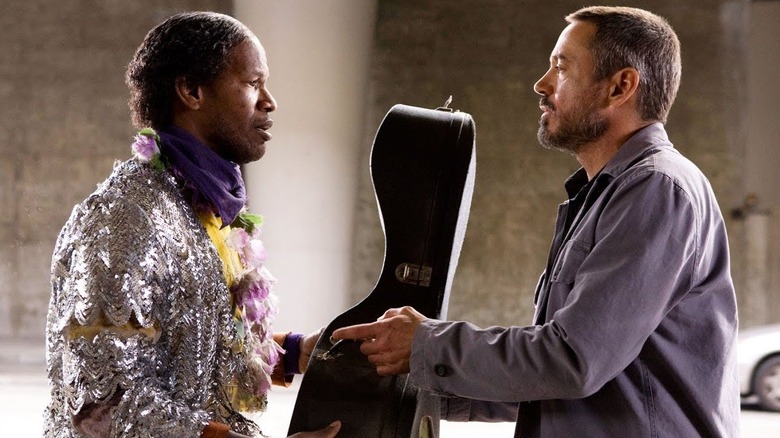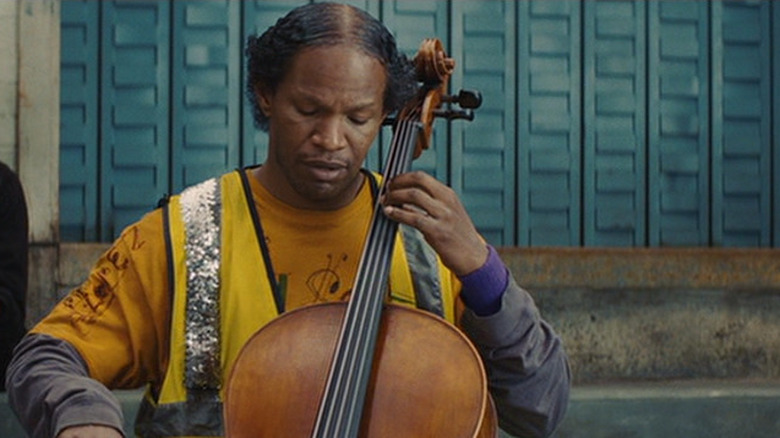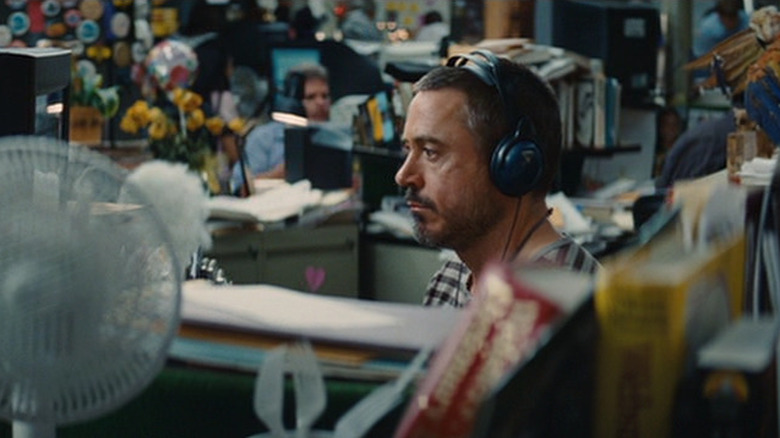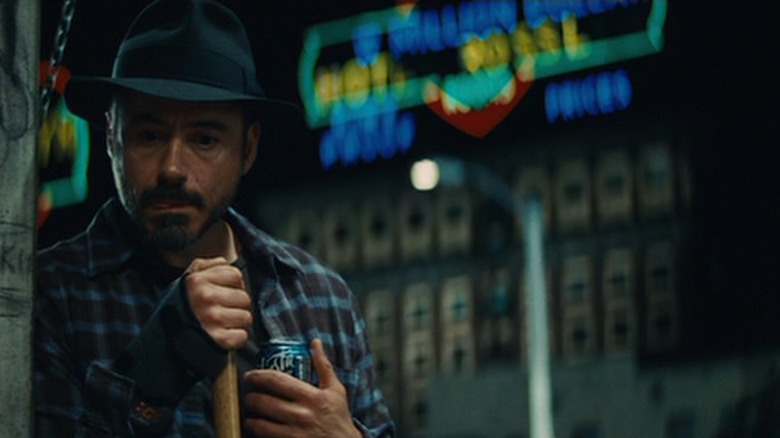How Joe Wright Convinced Robert Downey, Jr. To Take His Role In The Soloist
It was 2009 and Robert Downey, Jr. was becoming the face of the biggest movie franchise on the planet. As 2008's "Iron Man" kicked off the Marvel Cinematic Universe and catapulted Downey, Jr. back to A-list stardom, he was still in a place where he could be offered, and take, more eccentric roles in smaller films. To see the roles he was willing to take in the years between "Iron Man" and "The Avengers" is to see a great actor with renewed vitality, bankable from his stardom and still capable of doing interesting work. Even something like his role in his other massive 2008 hit "Tropic Thunder," with its broad comic overtones and eventual Oscar nomination, was fairly risky compared to what would come later. He even considered "Iron Man 2" a bit of a risk. But one particular unsung performance of his from this period was his role in Joe Wright's 2009 film "The Soloist."
It might not have been Downey's choice for his "best" role, but "The Soloist" still gives the actor ample room to build a complex, nuanced character. Telling the true story of Los Angeles Times columnist Steve Lopez (Robert Downey, Jr.) who forms a complicated, halfway-friendly relationship with an unhoused schizophrenic musician named Nathaniel Ayers (Jamie Foxx), the movie gave both actors compelling journeys to take. But Downey, on the cusp of a major career renaissance, had his doubts about taking the role, and needed convincing from director Joe Wright to take it.
Joe Wright wanted authenticity
"The Soloist" marked a departure for director Joe Wright, best-known at the time for his more period literary work like "Atonement" or 2005's "Pride and Prejudice." In those movies, Wright's precise filmmaking, with the help of production designer Sarah Greenwood, brought old worlds to life — now, the filmmakers needed to craft a contemporary world. It wouldn't be hard to make a newsroom drama. It would be harder to tell the story of Ayers with authenticity. Filmed among and around the homeless population of Los Angeles' Skid Row, "The Soloist" differentiated itself from traditional "inspirational true stories" by immersing viewers in those situations.
According to an interview with Wright on Popcornreel.com, the director's commitment to the movie was directly contingent on whether or not he would be able to work with real-life members of the LAMP Community, an L.A. nonprofit designed to end individual homelessness and address mental health concerns. In the movie, Lopez lures Ayers to LAMP with the promise of a handsome secondhand cello, telling him it needs to be kept secure.
"The Soloist" is filled with members of the LAMP Community, using Lopez's tape recorder as a narrative device like Mike Mills' 2021 film "C'mon C'mon," and letting them participate in its making in the form of interviews. Wright was able to more directly tell Nathaniel Ayers' story, showing the precipitous tightrope walked by people in his condition. The LAMP Community aspect of the movie was also its biggest draw for Robert Downey, Jr.
Convincing Downey to take the role
2007 saw Robert Downey, Jr. play another real-life journalist, Paul Avery, in David Fincher's masterful serial killer investigation "Zodiac." That movie was frontloaded with newsroom scenes and gave Downey the chance to play a charismatic, too-clever reporter, owning scenes just by walking into them — with the benefit of a murder plot in the background. Initially, he couldn't understand why he would want to retread old ground for Joe Wright's film. As he told Collider at a press screening for "The Soloist," his initial internal feeling was: "[W]hat do they think I'm going to do? I just played a journalist."
Per Downey, Wright and the film's producer Gary Foster apparently visited the actor on the Hawaii set of "Tropic Thunder," hoping to convince him to take the role there. Because "Tropic Thunder" was a massive blockbuster comedy, the promise of something smaller was one nugget they could offer. The other was the chance to work with the LAMP Community members. As Downey said:
"[Wright] wanted me there working with the LAMP members. He kept telling me the movie is not about you. The movie has nothing to do with you... it turned into this incredibly wonderfully humiliating three months on skid row, which is probably exactly what I needed."
Downey also alluded to the healing effect of working with the community in the context of his own troubles.
Robert Downey, Jr. on Skid Row
While Robert Downey, Jr.'s image now is colored fairly clean by the 11 years he spent playing Iron Man for the Marvel Cinematic Universe (with heartwarming moments taken from his own life), his troubles with drug addiction and its consequences once completely took over his reputation, for a large chunk of the '90s and early '00s. As the BBC reported in 1999, Downey had been a drug user since he was eight, and its hold on him was nearly impossible to combat. He spent time in jail and his career suffered setbacks.
Working with members of LAMP, Downey not only saw people who'd been dealt similar hands to him over the years — he even claimed to have reunited with people he knew from his stint in county jail nearly a decade previously. As he told Collider, his "street cred on Skid Row was pretty high" on account of his public persona and history. Because so much of the movie would involve Downey interviewing and improvising with these people, his comfort with them proved necessary. And it moved him too — he told Collider that Wright's major direction for him was to "observe," not dominate the scene, and consequently "being asked to escape myself." While he was willing to admit that the movie could be seen as "Hollywoodizing" mental illness and homelessness, he also felt that that aspect, of observation and really listening to people, made it worthwhile.



